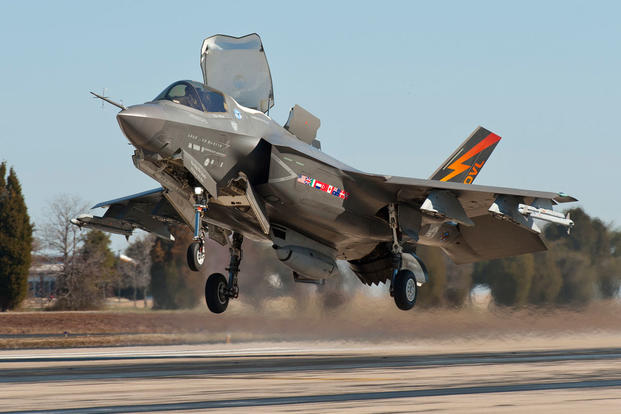FARNBOROUGH, England -- The Marines' F-35 Joint Strike Fighter has four deployments lined up across the next five years, a senior official said this week -- and some of them could take it into the heart of the coalition fight against the Islamic State.
Speaking at the Farnborough International Airshow on Monday, Col. William Lieblein said by 2021 the aircraft will have completed three shipboard pumps with a Marine Expeditionary Unit, and one on an aircraft carrier.
"2021 will be here before we know it," he said. "And that's about the same time we start really standing up a significant number of squadrons."
The F-35B "jump jet" variant of the Lockheed Martin aircraft declared initial operational capability just a year ago, and its first deployment has already been announced: Marine Fighter Attack Squadron 121 [VMFA-121], in Yuma, Arizona, will move permanently forward to Okinawa, Japan, where the aircraft will be sent out aboard the 31st MEU, which is also permanently forward-based in the Pacific.
Lieblein said other F-35 squadrons will then deploy with two West Coast MEUs, though he could not specify which units would take out the aircraft or when those deployments would take place. The three West Coast MEUs, based at Camp Pendleton, California, are the 11th, 13th and 15th. The 13th MEU deployed in February and began launching airstrikes on Islamic State militants in Iraq and Syria from the Persian Gulf.
Marine Corps spokeswoman Capt. Sarah Burns confirmed that it was a "very real possibility" that a West Coast-based MEU with a squadron of F-35s aboard could receive a similar tasking.
The first carrier deployment for the Marines will come in 2020, Lieblein said. While he could not name the carrier to deploy the aircraft, a Marine official said it may be the USS George H.W. Bush. The Marine Corps plans to acquire 63 F-35C carrier-variant Joint Strike Fighters, which have larger wings and foldable wingtips and are designed for arrested recovery landings. The F-35C is set to achieve IOC in 2018 or early 2019, shortly ahead of the planned deployment.
Lieblein said the transit across the Atlantic of three F-35Bs, two Marine Corps aircraft and one Royal Air Force bird, to the United Kingdom for participation in the Royal International Air Tattoo and Farnborough was a confidence-builder and was accomplished seamlessly, with the same mission profile and the same number of in-flight tanking evolutions that Lieblein had previously done in a Marine Corps F/A-18 Hornet.
"That was a major milestone for us and it demonstrated to ourselves and to everyone else that we can forward deploy this program whenever we want to," he said.
The F-35B is set to enter full-rate production in 2018, and the Marines' aggressive deployment schedule demonstrates how eager officials are to make use of the long-awaited platform.
But it's possible U.S. troops won't have to wait until late 2017 or 2018 to test the mettle of the fifth-generation fighter in combat.
The commander of Air Combat Command, Gen. Herb "Hawk" Carlisle, said Wednesday that he was prepared to deploy the F-35A Air Force variant immediately after the aircraft reaches IOC later this year.
"The minute I declare initial operational capability, if the combatant commander calls me up and says they needed F-35s, I would send them," Carlisle said, according to Bloomberg News.
-- Hope Hodge Seck can be reached at hope.seck@military.com. Follow her on Twitter at@HopeSeck.
Related Video:
Bullet Points: F35 Lightning II




























